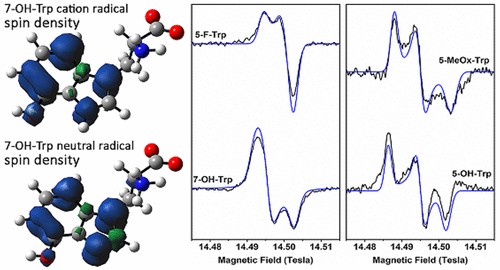当前位置:
X-MOL 学术
›
J. Phys. Chem. A
›
论文详情
Our official English website, www.x-mol.net, welcomes your feedback! (Note: you will need to create a separate account there.)
High-Frequency/High-Field Electron Paramagnetic Resonance and Theoretical Studies of Tryptophan-Based Radicals
The Journal of Physical Chemistry A ( IF 2.9 ) Pub Date : 2018-02-28 00:00:00 , DOI: 10.1021/acs.jpca.7b12434 Ian Davis 1, 2 , Teruaki Koto 1 , James R. Terrell 2 , Alexander Kozhanov 3 , J. Krzystek 4 , Aimin Liu 1
The Journal of Physical Chemistry A ( IF 2.9 ) Pub Date : 2018-02-28 00:00:00 , DOI: 10.1021/acs.jpca.7b12434 Ian Davis 1, 2 , Teruaki Koto 1 , James R. Terrell 2 , Alexander Kozhanov 3 , J. Krzystek 4 , Aimin Liu 1
Affiliation

|
Tryptophan-based free radicals have been implicated in a myriad of catalytic and electron transfer reactions in biology. However, very few of them have been trapped so that biophysical characterizations can be performed in a high-precision context. In this work, tryptophan derivative-based radicals were studied by high-frequency/high-field electron paramagnetic resonance (HFEPR) and quantum chemical calculations. Radicals were generated at liquid nitrogen temperature with a photocatalyst, sacrificial oxidant, and violet laser. The precise g-anisotropies of l- and d-tryptophan, 5-hydroxytryptophan, 5-methoxytryptophan, 5-fluorotryptophan, and 7-hydroxytryptophan were measured directly by HFEPR. Quantum chemical calculations were conducted to predict both neutral and cationic radical spectra for comparison with the experimental data. The results indicate that under the experimental conditions, all radicals formed were cationic. Spin densities of the radicals were also calculated. The various line patterns and g-anisotropies observed by HFEPR can be understood in terms of spin-density populations and the positioning of oxygen atom substitution on the tryptophan ring. The results are considered in the light of the tryptophan and 7-hydroxytryptophan diradical found in the biosynthesis of the tryptophan tryptophylquinone cofactor of methylamine dehydrogenase.
中文翻译:

色氨酸基自由基的高频/高场电子顺磁共振和理论研究
基于色氨酸的自由基与生物学中无数的催化和电子转移反应有关。但是,其中只有极少数被困住,因此可以在高精度环境下进行生物物理表征。在这项工作中,通过高频/高场电子顺磁共振(HFEPR)和量子化学计算研究了基于色氨酸衍生物的自由基。在液氮温度下用光催化剂,牺牲氧化剂和紫激光产生自由基。l和d的精确g各向异性通过HFEPR直接测量-色氨酸,5-羟基色氨酸,5-甲氧基色氨酸,5-氟色氨酸和7-羟基色氨酸。进行了量子化学计算,以预测中性和阳离子自由基光谱,以便与实验数据进行比较。结果表明,在实验条件下,所有形成的自由基均为阳离子。还计算了自由基的自旋密度。通过自旋密度种群和色氨酸环上氧原子取代的位置,可以理解HFEPR观察到的各种线型和g各向异性。根据在甲基胺脱氢酶的色氨酸色氨酸醌辅助因子的生物合成中发现的色氨酸和7-羟基色氨酸双自由基来考虑结果。
更新日期:2018-02-28
中文翻译:

色氨酸基自由基的高频/高场电子顺磁共振和理论研究
基于色氨酸的自由基与生物学中无数的催化和电子转移反应有关。但是,其中只有极少数被困住,因此可以在高精度环境下进行生物物理表征。在这项工作中,通过高频/高场电子顺磁共振(HFEPR)和量子化学计算研究了基于色氨酸衍生物的自由基。在液氮温度下用光催化剂,牺牲氧化剂和紫激光产生自由基。l和d的精确g各向异性通过HFEPR直接测量-色氨酸,5-羟基色氨酸,5-甲氧基色氨酸,5-氟色氨酸和7-羟基色氨酸。进行了量子化学计算,以预测中性和阳离子自由基光谱,以便与实验数据进行比较。结果表明,在实验条件下,所有形成的自由基均为阳离子。还计算了自由基的自旋密度。通过自旋密度种群和色氨酸环上氧原子取代的位置,可以理解HFEPR观察到的各种线型和g各向异性。根据在甲基胺脱氢酶的色氨酸色氨酸醌辅助因子的生物合成中发现的色氨酸和7-羟基色氨酸双自由基来考虑结果。



























 京公网安备 11010802027423号
京公网安备 11010802027423号